| Session Title | Session Description & Materials |
Day One - Welcome and Introductions |
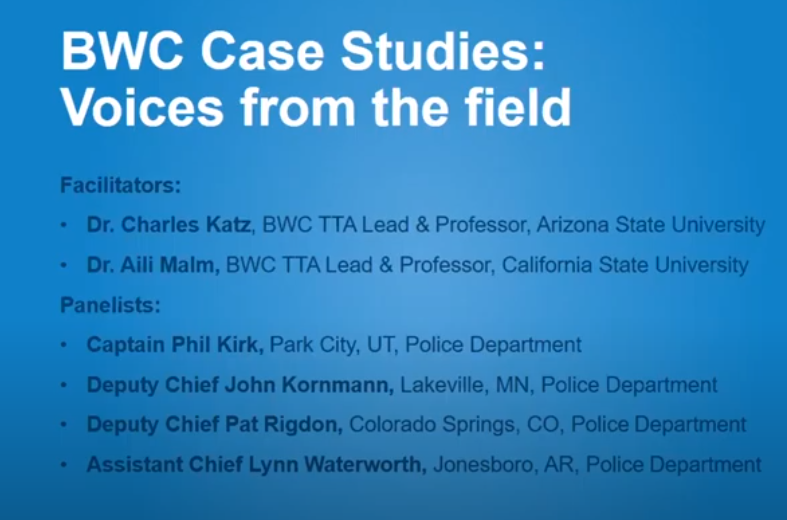 BWC Case Studies: Voices from the Field | Four BWC PIP sites (Park City, UT; Lakeville, MN; Colorado Springs, CO; and Jonesboro, AR) presented as a panel on their agencies' BWC programs and experience with the BWC PIP. BWC TTA Leads Charles Katz and Dr. Aili Malm facilitated the session.The presenters described their BWC initiatives and discussed their experiences implementing BWCs. The presentations covered wide-ranging lessons learned from the these agencies. Presenters discussed how departments have used BWCs, what has worked, what hasn’t, and what they have learned through their implementation processes. Access the recording |
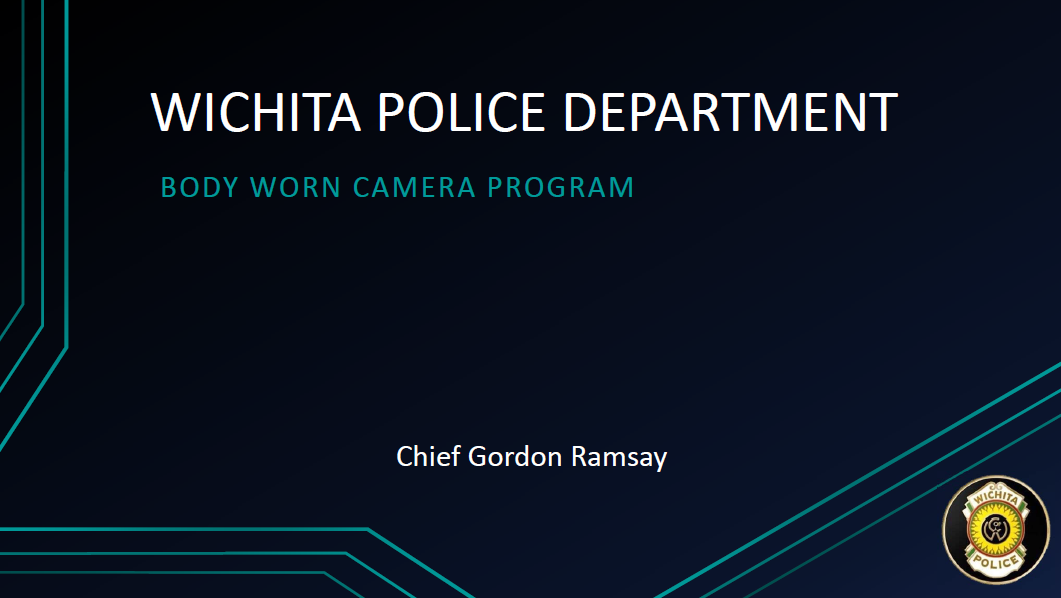
Keynote Presentation: Chief Gordon Ramsay, Wichita Police Department | Chief Gordon Ramsay of the Wichita Police Department discussed his agency’s experience implementing BWCs, lessons learned, and how they are advancing their BWC program. The Wichita Police Department is a nationally recognized leader in the field of policing and the use of BWCs. Chief Ramsay is also a Commissioner on the Presidential Commission on Law Enforcement and the Administration of Justice. Access the recording Access the slides |
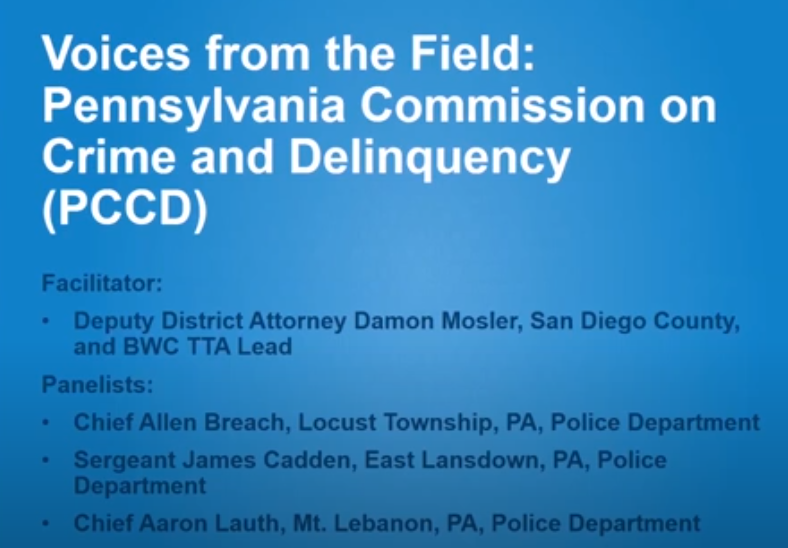
Voices from the Field: Pennsylvania Commission on Crime and Delinquency (PCCD) | Three 2018 BWC PIP subgrantees of the Pennsylvania Commission on Crime and Delinquency (PCCD) (Locust Township, PA; East Lansdown, PA; and Mt. Lebanon, PA) presented as a panel on their agencies’ BWC programs. BWC TTA Lead Damon Mosler facilitated the session.The presenters described their BWC initiatives and experiences implementing BWCs. The presentations covered wide-ranging lessons learned from these agencies. Panelists discussed how departments have used body-worn cameras, what has worked, what hasn’t, and what they have learned through their implementation processes. Access the recording |
Day Two - Fundamentals of a BWC Program |
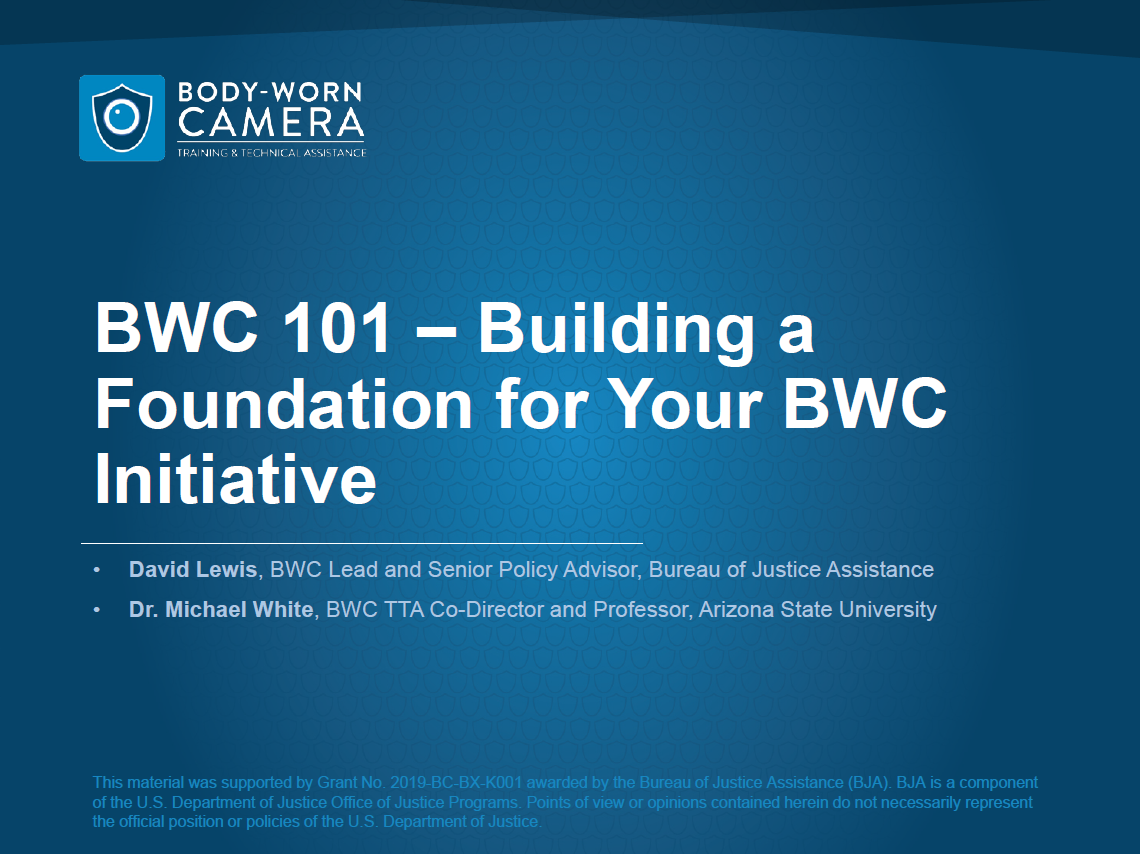
BWC 101 - Building a Foundation for your BWC Initiative | BJA Senior Policy Advisor David Lewis and the BWC TTA Co-Director Dr. Michael White discussed the emergence of BWCs as critical to evidence generation, officer and public safety, and police-community relations. They also provided a brief overview of the BJA BWC PIP, BJA BWC Toolkit, and TTA resources and discussed foundational elements of the BWC TTA Program. Access the recording |

BWC Policy: The Scorecard and Certification | This session--led by BWC TTA C-Director Dr. Mike White and BWC TTA Leads Director Orlando Cuevas and Chief (ret.) Harold Medlock--focused on the importance of BWC policy and the steps BWC PIP agencies must go through to pass the policy review process. This session covered the fundamentals of the BWC policy review process and included a review of the key mandatory elements of the BWC Policy Review Scorecard and Certification. Participants had the opportunity to ask questions about the policy review process and specific scorecard elements. Access the recording Access the slides |

Searching for Answers: What are the effects of BWCs on police behavior? | This session focused on what we know, based on research, regarding the effects of BWCs on police behavior. BWC TTA SMEs Dr. Craig Uchida, Dr. Aili Malm, and Lt. (ret.) Tom Woodmansee provided a high-level review of the available research on the topic, and discussed what the research results may mean for an agency implementing and using BWCs. Access the recording Access the slides |
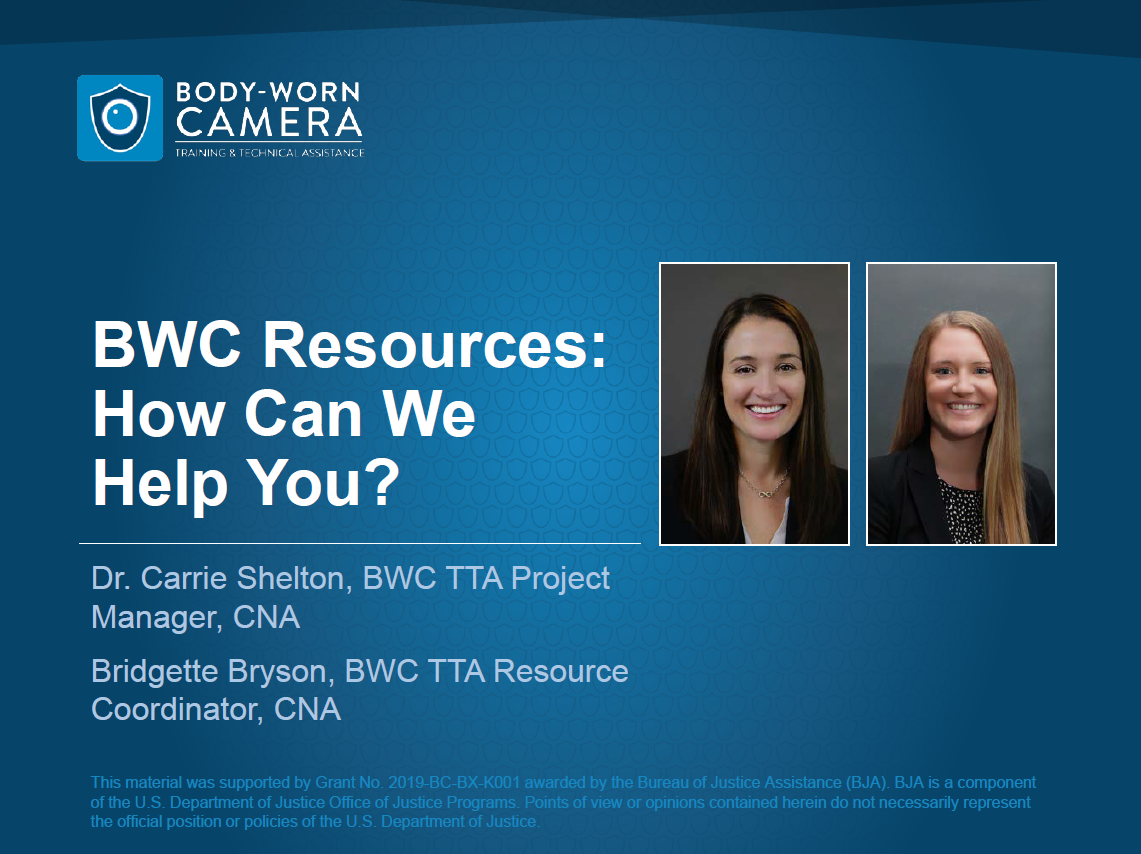
BWC Resources: How can we help you? | BWC TTA provides a wide array of resources in a variety of formats (e.g., on-site subject matter experts, peer-to-peer exchanges, webinars, In View commentaries). In this session, BWC TTA Resource Coordinator Bridgette Bryson and BWC TTA Project Manager Carrie Shelton provided an overview of the resources currently available to both BWC PIP sites and non-funded law enforcement agencies. Session attendees had the opportunity to share any TTA needs they have as well as to discuss any resources they would like to see developed. Access the recording Access the slides |
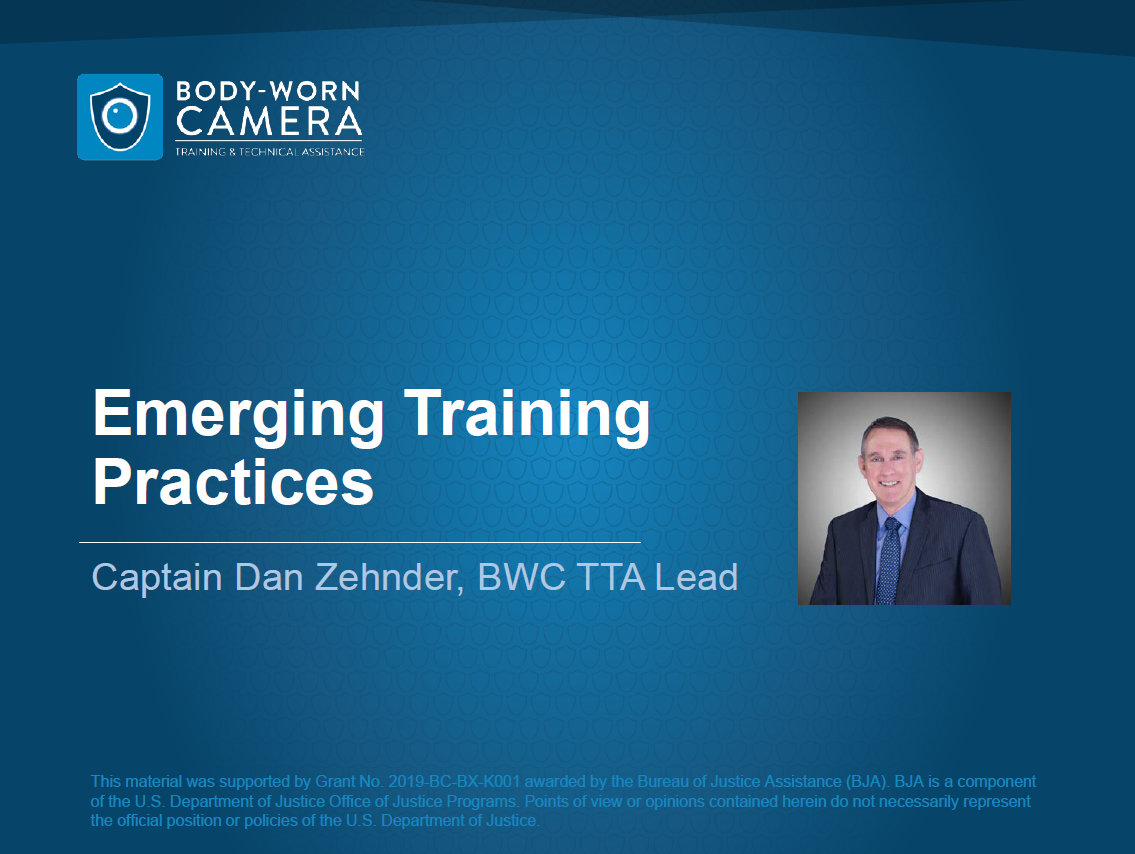
Emerging training practices | This session--led by BWC TTA Lead Captain (ret.) Dan Zehnder--focused on emerging training practices, including both training on how to use BWCs and how BWCs can be a useful training tool for various types of operations. Session participants shared their experiences and needs related to BWC training. The session also covered the BWC TTA training resources available to BWC sites. Access the recording Access the slides |
Day 3: Advancing your BWC Program |
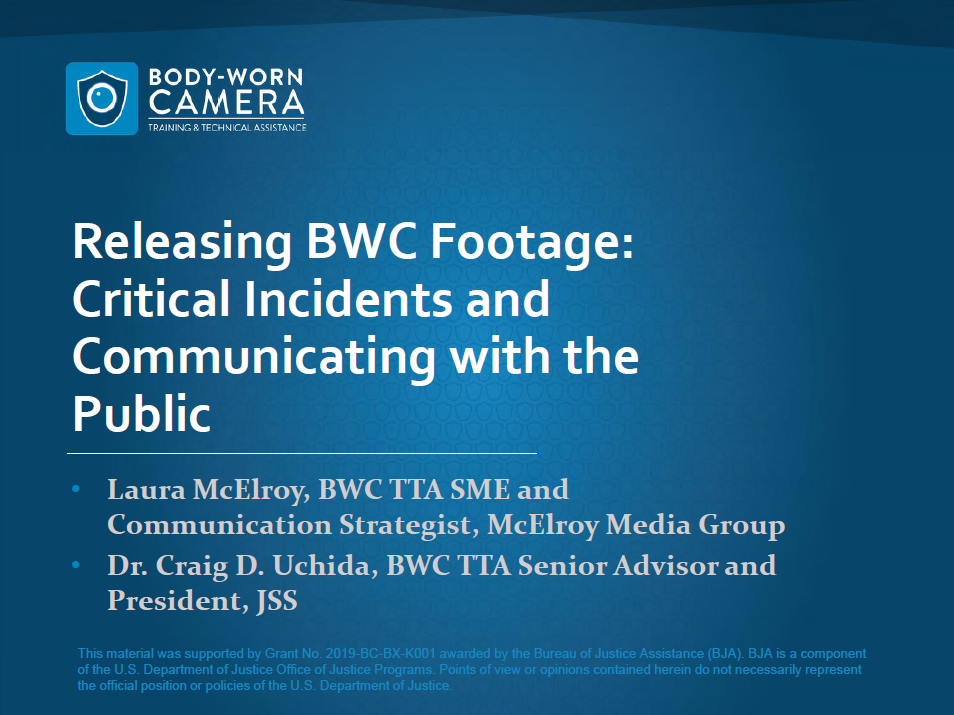
Releasing BWC footage: Critical incidents and communicating with the public | Laura McElroy, BWC TTA SME and Communications Strategist, discussed releasing BWC videos and communicating with the public following a critical incident, including the media perspective. BWC TTA Senior Advisor Dr. Craig Uchida discussed BWC evidence following an officer-involved shooting or other critical incident, including supervisor actions, camera deactivation, and chain of custody. Access the recording Access the slides |
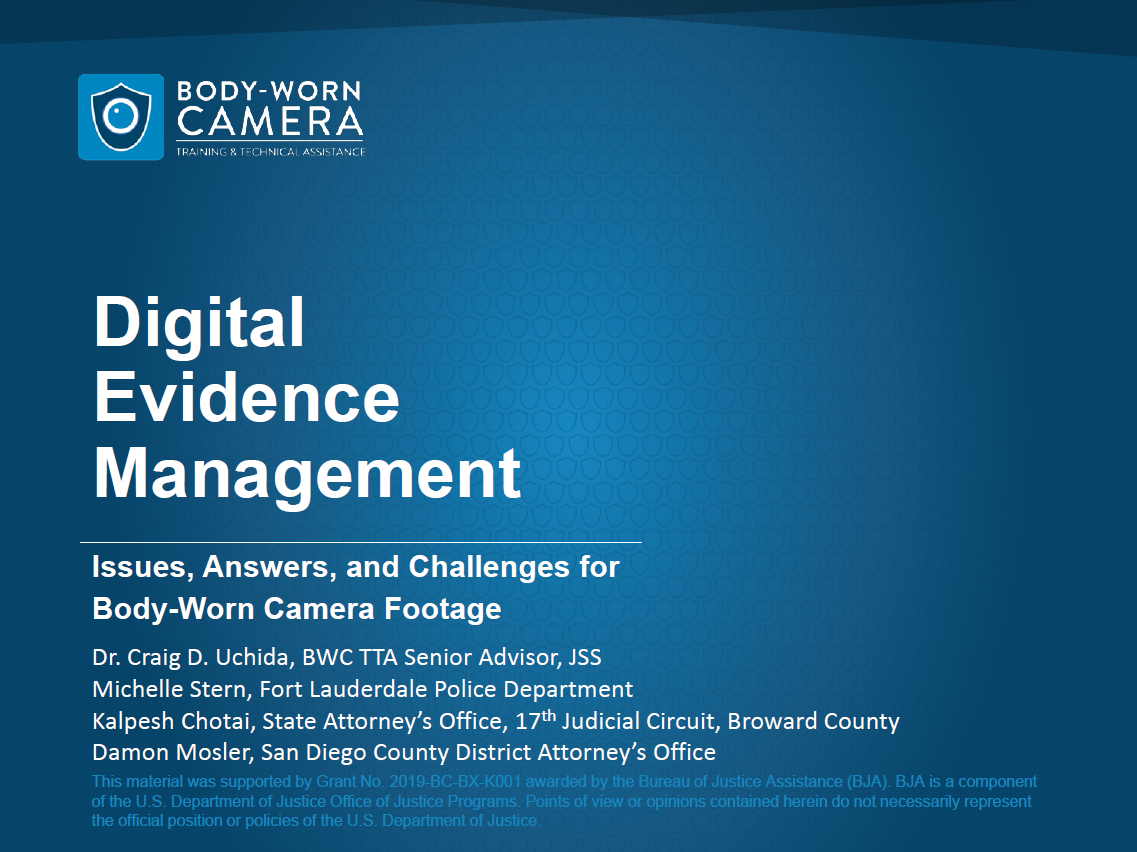
Meeting the challenges of managing digital media evidence: Working with prosecutors, using analytics and redaction tools | Digital media evidence may include, but is not limited to, body-worn camera video, in-car video, and automated license plate readers. During this session, facilitated by BWC TTA Senior Advisor Dr. Craig Uchida, participants learned best practices and considerations for managing digital media evidence. Michelle Stern, Ft. Lauderdale, FL, Police Department; Kalpesh Chotai, Office of the State Attorney, Broward County, FL; and BWC TTA Lead and Deputy District Attorney Damon Mosler presented on their experiences managing digital evidence. This workshop also examined the ways in which BWC footage can be used most effectively by prosecutors as well as members of law enforcement. It addressed the importance of communication on how to receive, review, redact, and discover digital media evidence. It also looked at what to expect from the defense when using videos, as well as strategies to help juries understand and accept graphic videos. Access the recording Access the slides |
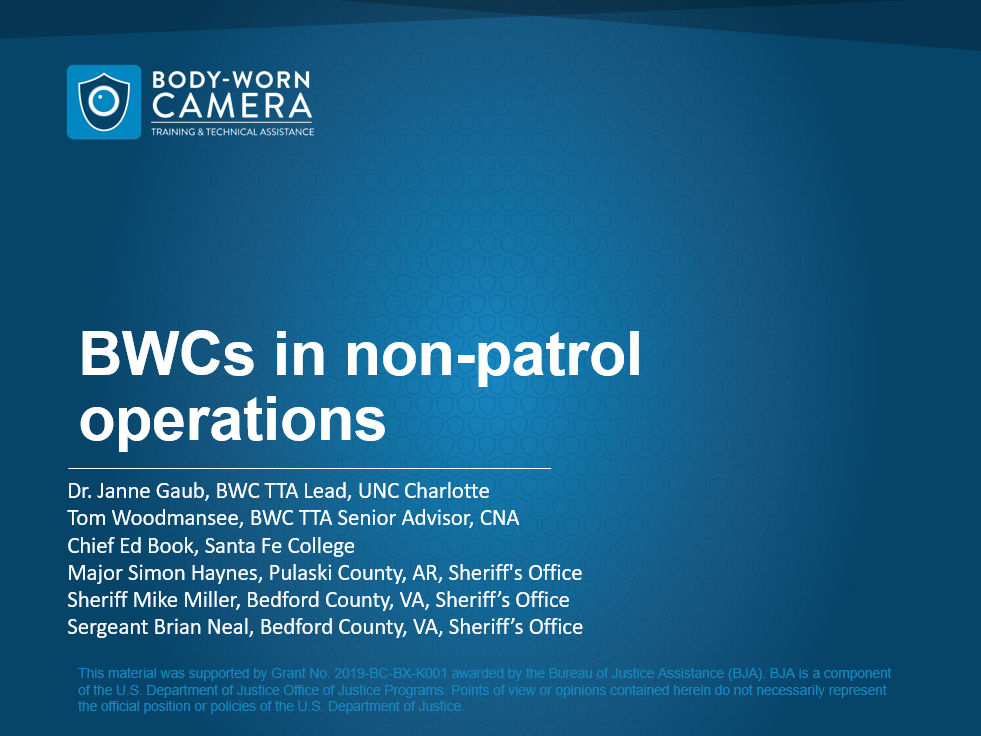
BWCs in non-patrol operations (e.g. SROs, SWAT, corrections, fire marshals, EMTs) | This session--facilitated by BWC TTA Senior Advisor Tom Woodmansee and BWC TTA Lead Dr. Janne Gaub--covered the use of BWCs by entities other than patrol officers, including use of BWCs by Special Weapons and Tactics units, detectives, School Resource Officers, correctional entities, civil service officers, fire departments, and others. Representatives from Pulaski County, AR, Sheriff's Office and Bedford County, VA, discussed providing BWCs to various entities within their organizations. Access the recording |

Complying with BWC policy: Monitoring and auditing BWC usage | This session, facilitated by BWC TTA Lead Dan Zehnder, focused on issues, concepts, and approaches to BWC video auditing and compliance monitoring, covering topics such as the important role of compliance monitoring in BWC programs, different levels of monitoring (e.g., monitoring individual officer, program, or organizational performance), and suggested approaches for implementing compliance monitoring programs. It also included discussion on various compliance monitoring programs that PIP sites have implemented, which were described by three panelists from BWC PIP sites (Camden County, NJ; Baltimore, MD; and St. Anthony, MN) covering the monitoring policies, practices, and lessons learned within their agencies. Access the recording |

What's new in BWC (and related) technology? | This session--facilitated by BWC TTA Senior Advisor Tom Woodmansee and including BWC TTA Technology Advisor Elliot Harkavy; Assistant Chief Dinesh Patil, Montgomery County, MD; and BWC TTA Lead Director Eddie Reyes--covered the latest advancements in BWC and related technology, such as BWC live streaming, GPS tagging, auto-triggering, integration with CAD/RMS, integration with in-car cameras, video analytics and redaction, and other technological advancements. Presenters discussed the potential uses, benefits, and considerations for implementing these technologies. Access the recording |
Day 4: Managing your BWC grant and procurement |
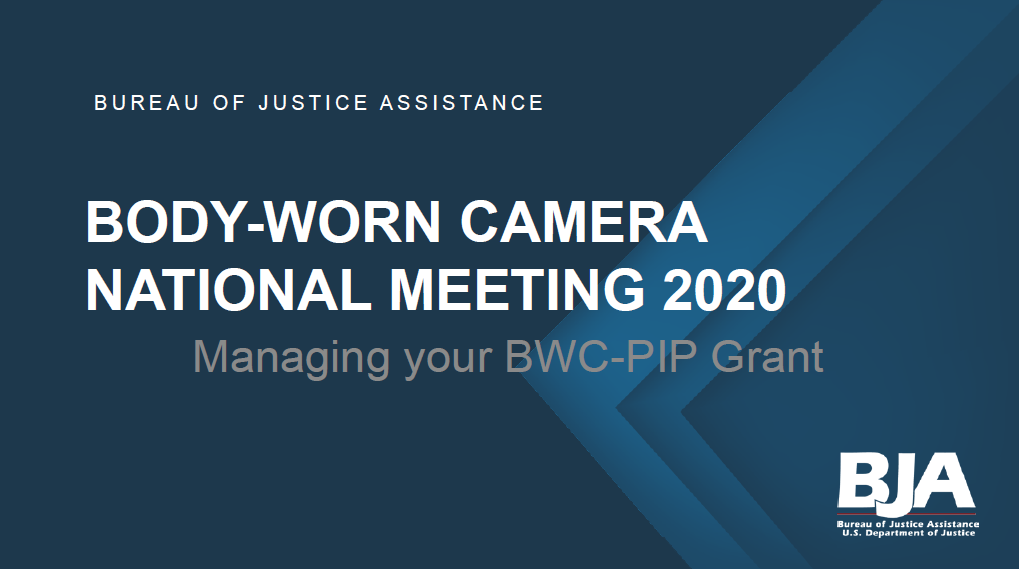
Managing your BJA BWC PIP Grant | BJA representatives reviewed the overall requirements for the BJA BWC PIP grant. They highlighted best practices and common pitfalls for grantees. Access the recording |
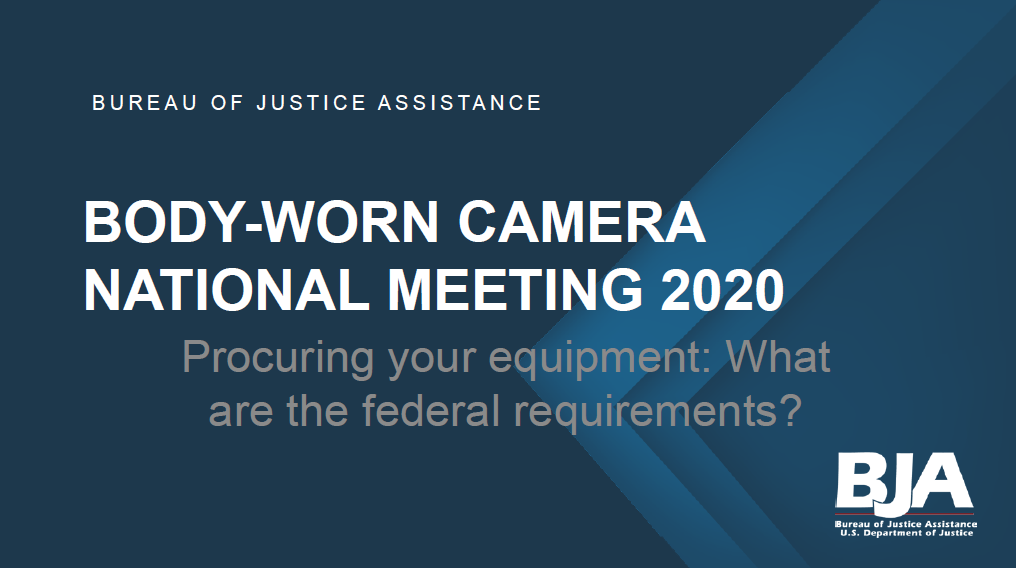
Procuring your equipment: What are the federal requirements? | This session helped participants understand a variety of factors that affect BWC program costs and benefits. Featuring three panelists with experiences implementing BWC programs, the session highlighted many unexpected costs that agencies, and their criminal justice partners, have confronted as they implemented the BWC program. It also demonstrated the BWC Cost Calculator that can be used by agencies to help estimate BWC program costs and benefits. Access the recording |
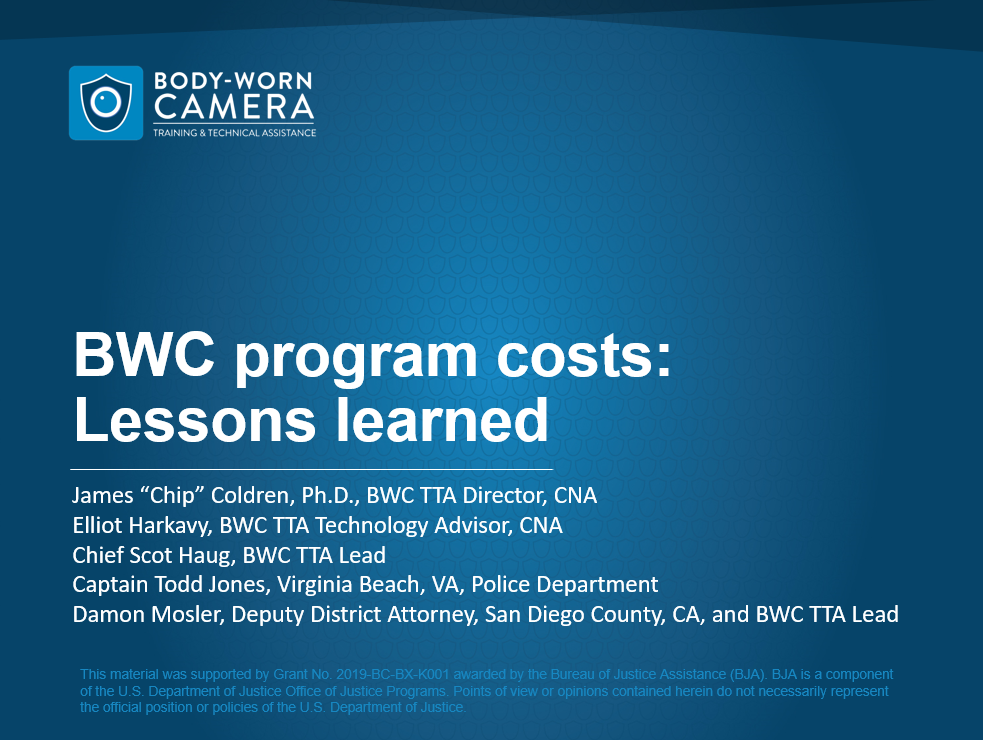
BWC program costs: Lessons learned | In this session, facilitated by BWC TTA Director Dr. Chip Coldren, the panelists--BWC TTA Technology Advisor Elliot Harkavy; BWC TTA Lead Chief (ret.) Scot Haug; Captain Todd Jones, Virginia Beach, VA, Police Department; and BWC TTA Lead Damon Mosler--discussed a variety of factors that affect BWC program costs and benefits. The session highlighted many unexpected costs that agencies, and their criminal justice partners, have confronted as they implemented BWC programs. It also demonstrated the BWC Cost and Storage Estimator that can be used by agencies to help estimate BWC program costs and benefits. Access the recording |

BJA's BWC performance measurement | This presentation delved into how BJA uses performance measures to assist the grantees, improve BJA programs, make good decisions, and report to the Hill on how funds are spent. Access the recording |
